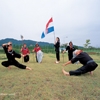europe | Hwaran Mudosul
페이지 정보
작성자 WoMAU 작성일11-07-27 1,083회 댓글0건관련링크
본문
Hwaran Mudosul
Netherlands

1. History
The Dutch combat (Hwaran Mudosul) is a martial art form, which is created by Kiback from the Netherlands. He combined Hwarang Musul and Dutch combats to create a modernized Dutch martial art.
The techniques and its philosophy are influenced by European martial arts from the early medieval (between the fifth and seventh century) and the late medieval (fifteenth century).
This period was characterized by wars on battle-fields. They used weapons such as spears, axes, maces, swords, the shields of "drop" shapes and large round shields to defend themselves and eliminate their enemies.
The sword, for example, had a simple but functional design. It consisted of a blade with two parallel sides, a round point and a simple straight plate.
The design of this sword was made especially for using with one hand. Using this sword with techniques was effective to give heavy smacks and to cut. Carrying this weapon in the one hand and a shield in the other formed an effective and deadly combination.
2. Philosophy
The Dutch combat is a combined martial art movement in which western and eastern martial art elements are integrated. It is a combination of Dutch combats and its culture and eastern martial arts. It can be said that the both cultures are integrated in this arts.
The Dutch combats with their rough weapons and the soft movements of eastern martial art forms a unique combination. Both Asian and Dutch martial arts can be recognized in practice sessions such as respect, politeness and fighting spirits.
3. Contents
1) Technic
The Hwa-Ran gladiaters used swords, axes, spears, maces, and various other weaponry to defeat their enemies and in hand to hand, they used techniques holding, twisting and throwing over the shoulder that resemble wrestling.
Fighting movements:
The Dutch combat seems to have movements from diverse wrestling techniques. These are combined with kicking movements.
2) Style
3) Rank & Grade
4. Organization
댓글목록
등록된 댓글이 없습니다.



